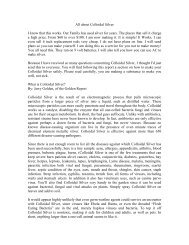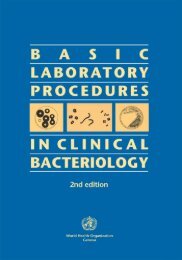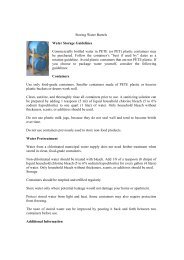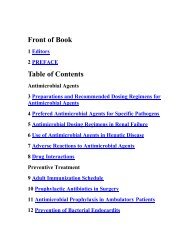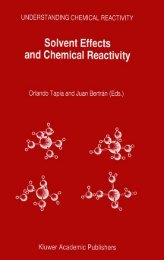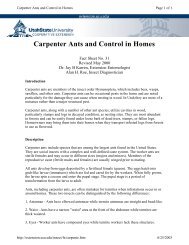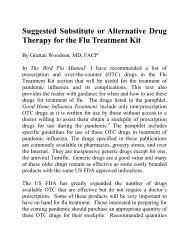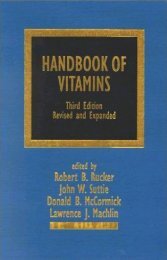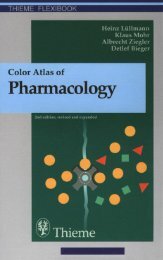- Page 2: X-Ray Spectrometry:Recent Technolog
- Page 8: Copyright © 2004John Wiley & Sons
- Page 14: ContributorsF. AdamsDepartment of C
- Page 18: CONTRIBUTORSixB. K. TannerBEDE Scie
- Page 24: xiiPREFACEto cover all the importan
- Page 30: THE ROLE AND POSITION OF XRS IN ANA
- Page 34: THE ROLE AND POSITION OF XRS IN ANA
- Page 38: VOLUME OUTLINE 7The third chapter i
- Page 42: VOLUME OUTLINE 9Physics, University
- Page 46: REFERENCE 11(versus other technique
- Page 52: 14 MICRO X-RAY SOURCESTable 2.1.1 P
- Page 56: 16 MICRO X-RAY SOURCESF80GHESource
- Page 60: 18 MICRO X-RAY SOURCES(1) If the di
- Page 64: 20 MICRO X-RAY SOURCES(a)(b)Figure
- Page 68: 22 MICRO X-RAY SOURCESthe rotating
- Page 72: 24 MICRO X-RAY SOURCES10 5 −5000
- Page 76: 26 MICRO X-RAY SOURCESuntil it was
- Page 82:
2.2 New Synchrotron Radiation Sourc
- Page 86:
INTRODUCTION 31Table 2.2.1 Synchrot
- Page 90:
THIRD GENERATION SOURCES AND OTHER
- Page 94:
THIRD GENERATION SOURCES AND OTHER
- Page 98:
THIRD GENERATION SOURCES AND OTHER
- Page 102:
THIRD GENERATION SOURCES AND OTHER
- Page 106:
FOURTH GENERATION SOURCES 415Intens
- Page 110:
FOURTH GENERATION SOURCES 43Electro
- Page 114:
FOURTH GENERATION SOURCES 45Peak br
- Page 118:
REFERENCES 478. Walker, R. P. and D
- Page 124:
50 LASER-DRIVEN X-RAY SOURCESrange
- Page 128:
52 LASER-DRIVEN X-RAY SOURCESTable
- Page 132:
54 LASER-DRIVEN X-RAY SOURCESin sil
- Page 136:
56 LASER-DRIVEN X-RAY SOURCESextrem
- Page 140:
58 LASER-DRIVEN X-RAY SOURCESclose
- Page 144:
60 LASER-DRIVEN X-RAY SOURCESpower
- Page 148:
62 LASER-DRIVEN X-RAY SOURCESWang,
- Page 152:
64 MULTILAYERS FOR SOFT AND HARD X-
- Page 156:
66 MULTILAYERS FOR SOFT AND HARD X-
- Page 160:
68 MULTILAYERS FOR SOFT AND HARD X-
- Page 164:
70 MULTILAYERS FOR SOFT AND HARD X-
- Page 168:
72 MULTILAYERS FOR SOFT AND HARD X-
- Page 172:
74 MULTILAYERS FOR SOFT AND HARD X-
- Page 176:
76 MULTILAYERS FOR SOFT AND HARD X-
- Page 180:
78 MULTILAYERS FOR SOFT AND HARD X-
- Page 184:
80 SINGLE CAPILLARIES X-RAY OPTICST
- Page 188:
82 SINGLE CAPILLARIES X-RAY OPTICSD
- Page 192:
84 SINGLE CAPILLARIES X-RAY OPTICS(
- Page 196:
86 SINGLE CAPILLARIES X-RAY OPTICSF
- Page 202:
3.3 Polycapillary X-ray OpticsN. GA
- Page 206:
FUNDAMENTALS OF POLYCAPILLARY OPTIC
- Page 210:
FOCUSING OPTICS 93to the axis, whic
- Page 214:
FOCUSING OPTICS 95small X-ray sourc
- Page 218:
COLLIMATING OPTICS 97minimal workin
- Page 222:
ANALYTICAL APPLICATIONS OF POLYCAPI
- Page 226:
ANALYTICAL APPLICATIONS OF POLYCAPI
- Page 230:
ANALYTICAL APPLICATIONS OF POLYCAPI
- Page 234:
ANALYTICAL APPLICATIONS OF POLYCAPI
- Page 238:
ANALYTICAL APPLICATIONS OF POLYCAPI
- Page 242:
REFERENCES 109working space between
- Page 246:
3.4 Parabolic Compound Refractive X
- Page 250:
PHYSICS OF REFRACTIVE X-RAY LENSES
- Page 254:
PHYSICS OF REFRACTIVE X-RAY LENSES
- Page 258:
APPLICATIONS 117As the dimensions o
- Page 262:
APPLICATIONS 11910 times less. The
- Page 266:
APPLICATIONS 121certified standards
- Page 270:
APPLICATIONS 123The attenuation sig
- Page 274:
APPLICATIONS 125to be a 2D slice of
- Page 278:
APPLICATIONS 127with the penetratin
- Page 282:
REFERENCES 1292CdCl 2Absorbance (ar
- Page 286:
REFERENCES 13145. S. Bohic, A. Simi
- Page 292:
134 SEMICONDUCTOR DETECTORS FOR (IM
- Page 296:
136 SEMICONDUCTOR DETECTORS FOR (IM
- Page 300:
138 SEMICONDUCTOR DETECTORS FOR (IM
- Page 304:
140 SEMICONDUCTOR DETECTORS FOR (IM
- Page 308:
142 SEMICONDUCTOR DETECTORS FOR (IM
- Page 312:
144 SEMICONDUCTOR DETECTORS FOR (IM
- Page 316:
146 SEMICONDUCTOR DETECTORS FOR (IM
- Page 320:
148 SEMICONDUCTOR DETECTORS FOR (IM
- Page 324:
150 SEMICONDUCTOR DETECTORS FOR (IM
- Page 328:
152 SEMICONDUCTOR DETECTORS FOR (IM
- Page 332:
154 SEMICONDUCTOR DETECTORS FOR (IM
- Page 336:
156 SEMICONDUCTOR DETECTORS FOR (IM
- Page 340:
158 SEMICONDUCTOR DETECTORS FOR (IM
- Page 344:
160 SEMICONDUCTOR DETECTORS FOR (IM
- Page 348:
162 SEMICONDUCTOR DETECTORS FOR (IM
- Page 352:
164 SEMICONDUCTOR DETECTORS FOR (IM
- Page 356:
166 SEMICONDUCTOR DETECTORS FOR (IM
- Page 360:
168 SEMICONDUCTOR DETECTORS FOR (IM
- Page 364:
170 SEMICONDUCTOR DETECTORS FOR (IM
- Page 368:
172 SEMICONDUCTOR DETECTORS FOR (IM
- Page 372:
174 SEMICONDUCTOR DETECTORS FOR (IM
- Page 376:
176 SEMICONDUCTOR DETECTORS FOR (IM
- Page 380:
178 SEMICONDUCTOR DETECTORS FOR (IM
- Page 384:
180 SEMICONDUCTOR DETECTORS FOR (IM
- Page 388:
182 SEMICONDUCTOR DETECTORS FOR (IM
- Page 392:
184 SEMICONDUCTOR DETECTORS FOR (IM
- Page 396:
186 SEMICONDUCTOR DETECTORS FOR (IM
- Page 400:
188 SEMICONDUCTOR DETECTORS FOR (IM
- Page 404:
190 SEMICONDUCTOR DETECTORS FOR (IM
- Page 408:
192 SEMICONDUCTOR DETECTORS FOR (IM
- Page 414:
4.2 Gas Proportional Scintillation
- Page 418:
THE PHYSICSOFTHEABSORPTION OF X-RAY
- Page 422:
THE PHYSICSOFTHEABSORPTION OF X-RAY
- Page 426:
THE PHYSICSOFTHEABSORPTION OF X-RAY
- Page 430:
TRANSPORT OF ELECTRONS IN Xe 20325X
- Page 434:
TRANSPORT OF ELECTRONS IN Xe 205Ele
- Page 438:
THE GAS PROPORTIONAL SCINTILLATION
- Page 442:
THE GAS PROPORTIONAL SCINTILLATION
- Page 446:
APPLICATIONS OF GAS PROPORTIONAL SC
- Page 450:
ACKNOWLEDGEMENTS 213Andalusite (AI
- Page 454:
REFERENCES 21523. Santos, F. P., Di
- Page 460:
218 SUPERCONDUCTING TUNNEL JUNCTION
- Page 464:
∋220 SUPERCONDUCTING TUNNEL JUNCT
- Page 468:
222 SUPERCONDUCTING TUNNEL JUNCTION
- Page 472:
224 SUPERCONDUCTING TUNNEL JUNCTION
- Page 476:
226 SUPERCONDUCTING TUNNEL JUNCTION
- Page 482:
4.4 Cryogenic MicrocalorimetersM. G
- Page 486:
MICROCALORIMETERS 231consequently s
- Page 490:
PERFORMANCE 233JFET for the first s
- Page 494:
PERFORMANCE 235that depends on the
- Page 498:
CURRENT DEVELOPMENTS 237of TES that
- Page 502:
CURRENT DEVELOPMENTS 239X-rayTherma
- Page 506:
CURRENT DEVELOPMENTS 24112010080Fit
- Page 510:
REFERENCES 243absorber geometries,
- Page 514:
REFERENCES 245Tan, P., Cooley, L. D
- Page 520:
248 POSITION SENSITIVE SEMICONDUCTO
- Page 524:
250 POSITION SENSITIVE SEMICONDUCTO
- Page 528:
252 POSITION SENSITIVE SEMICONDUCTO
- Page 532:
254 POSITION SENSITIVE SEMICONDUCTO
- Page 536:
256 POSITION SENSITIVE SEMICONDUCTO
- Page 540:
258 POSITION SENSITIVE SEMICONDUCTO
- Page 544:
260 POSITION SENSITIVE SEMICONDUCTO
- Page 548:
262 POSITION SENSITIVE SEMICONDUCTO
- Page 552:
264 POSITION SENSITIVE SEMICONDUCTO
- Page 556:
266 POSITION SENSITIVE SEMICONDUCTO
- Page 560:
268 POSITION SENSITIVE SEMICONDUCTO
- Page 564:
270 POSITION SENSITIVE SEMICONDUCTO
- Page 568:
272 POSITION SENSITIVE SEMICONDUCTO
- Page 572:
274 POSITION SENSITIVE SEMICONDUCTO
- Page 578:
Chapter 5Special Configurations5.1
- Page 582:
MODERN TOTAL REFLECTION X-RAY FLUOR
- Page 586:
MODERN TOTAL REFLECTION X-RAY FLUOR
- Page 590:
SURFACE AND INTERFACE ANALYSIS OF L
- Page 594:
SURFACE AND INTERFACE ANALYSIS OF L
- Page 598:
MICRO X-RAY FLUORESCENCE IMAGING 28
- Page 602:
FUTURE OUTLOOK 289X-Ray image4.8 mm
- Page 606:
REFERENCES 29145. B. W. Batterman,
- Page 612:
294 GRAZING-EXIT X-RAY SPECTROMETRY
- Page 616:
296 GRAZING-EXIT X-RAY SPECTROMETRY
- Page 620:
298 GRAZING-EXIT X-RAY SPECTROMETRY
- Page 624:
300 GRAZING-EXIT X-RAY SPECTROMETRY
- Page 628:
302 GRAZING-EXIT X-RAY SPECTROMETRY
- Page 632:
304 GRAZING-EXIT X-RAY SPECTROMETRY
- Page 638:
5.3 Portable Equipment for X-ray Fl
- Page 642:
INSTRUMENTATION 309of small size X-
- Page 646:
INSTRUMENTATION 311350030002500X-Ra
- Page 650:
INSTRUMENTATION 313Table 5.3.2 Char
- Page 654:
INSTRUMENTATION 315FWHM (eV)6005505
- Page 658:
INSTRUMENTATION 317Table 5.3.3 Comp
- Page 662:
INSTRUMENTATION 319EISFigure 5.3.10
- Page 666:
INSTRUMENTATION 321Figure 5.3.11 EI
- Page 670:
INSTRUMENTATION 323Table 5.3.5 Dete
- Page 674:
INSTRUMENTATION 325(a)(b)(c)"Unlimi
- Page 678:
INSTRUMENTATION 327Table 5.3.6 Mini
- Page 682:
APPLICATIONS 329Figure 5.3.22 The L
- Page 686:
APPLICATIONS 331Figure 5.3.24 Porta
- Page 690:
APPLICATIONS 3332600240022002000180
- Page 694:
APPLICATIONS 335lead-based poisonin
- Page 698:
APPLICATIONS 337• Provided in sit
- Page 702:
REFERENCES 339a ring-type geometry
- Page 706:
REFERENCES 341contamination associa
- Page 712:
344 SYNCHROTRON RADIATION FOR MICRO
- Page 716:
346 SYNCHROTRON RADIATION FOR MICRO
- Page 720:
348 SYNCHROTRON RADIATION FOR MICRO
- Page 724:
350 SYNCHROTRON RADIATION FOR MICRO
- Page 728:
352 SYNCHROTRON RADIATION FOR MICRO
- Page 734:
5.5 High-energy X-ray FluorescenceI
- Page 738:
PERFORMANCE OF HIGH-ENERGY XRF 3571
- Page 742:
PERFORMANCE OF HIGH-ENERGY XRF 359S
- Page 746:
PERFORMANCE OF HIGH-ENERGY XRF 3611
- Page 750:
APPLICATION OF HIGH-ENERGY XRF 3631
- Page 754:
APPLICATION OF HIGH-ENERGY XRF 3651
- Page 758:
APPLICATION OF HIGH-ENERGY XRF 367S
- Page 762:
APPLICATION OF HIGH-ENERGY XRF 369A
- Page 766:
REFERENCES 371SPring-8 utilizing th
- Page 770:
5.6 Low-energy Electron Probe Micro
- Page 774:
LOW-ENERGY SEM AND HIGH-RESOLUTION
- Page 778:
APPLICATIONS 377Figure 5.6.1 ‘Fis
- Page 782:
APPLICATIONS 379100 nm100 nmFigure
- Page 786:
APPLICATIONS 381TEM was soon abando
- Page 790:
APPLICATIONS 3831 µm2 µmsSulfurFS
- Page 794:
REFERENCES 385casing when this is r
- Page 798:
5.7 Energy Dispersive X-ray Microan
- Page 802:
SIGNALS GENERATED IN A THIN TEM SPE
- Page 806:
SIGNALS GENERATED IN A THIN TEM SPE
- Page 810:
ELECTRON ENERGY LOSS SPECTROSCOPY V
- Page 814:
QUANTITATIVE ANALYSIS IN EDX 3951(a
- Page 818:
QUANTITATIVE ANALYSIS IN EDX 397the
- Page 822:
QUANTITATIVE ANALYSIS IN EDX 399max
- Page 826:
QUANTITATIVE ANALYSIS IN EDX 401of
- Page 830:
CONCLUSION 403(At %)(At %)656361595
- Page 834:
5.8 X-Ray Absorption TechniquesJ. K
- Page 838:
EXTREME CONDITIONS 407Figure 5.8.3
- Page 842:
COMBINATION WITH OPTICAL LUMINESCEN
- Page 846:
PHOTOCONDUCTIVE AND ELECTROCHEMICAL
- Page 850:
TOTAL REFLECTION XAFS 413q >> δ cP
- Page 854:
STRONG FIELD EFFECTS 415Absorbance
- Page 858:
STRONG FIELD EFFECTS 417Dispersed X
- Page 862:
EELS, ELNES AND EXELFS 4195.8.11 MI
- Page 866:
EXEFS 421Figure 5.8.25 An inner str
- Page 870:
STANDARDIZATION 423oscillation is d
- Page 874:
STANDARDIZATION 425Sc 2 O 3TiO 2MnO
- Page 878:
SUMMARY 427Figure 5.8.32 Ritsumeika
- Page 882:
REFERENCES 429This shortcoming has
- Page 886:
REFERENCES 43195. Tanaka, T., Bando
- Page 890:
REFERENCES 433192. Citrin, P. H. Su
- Page 896:
436 MONTE CARLO SIMULATION FOR X-RA
- Page 900:
438 MONTE CARLO SIMULATION FOR X-RA
- Page 904:
440 MONTE CARLO SIMULATION FOR X-RA
- Page 908:
442 MONTE CARLO SIMULATION FOR X-RA
- Page 912:
444 MONTE CARLO SIMULATION FOR X-RA
- Page 916:
446 MONTE CARLO SIMULATION FOR X-RA
- Page 920:
448 MONTE CARLO SIMULATION FOR X-RA
- Page 924:
450 MONTE CARLO SIMULATION FOR X-RA
- Page 928:
452 MONTE CARLO SIMULATION FOR X-RA
- Page 932:
454 MONTE CARLO SIMULATION FOR X-RA
- Page 936:
456 MONTE CARLO SIMULATION FOR X-RA
- Page 940:
458 MONTE CARLO SIMULATION FOR X-RA
- Page 944:
460 MONTE CARLO SIMULATION FOR X-RA
- Page 950:
6.2 Spectrum EvaluationP. LEMBERGEU
- Page 954:
LEAST-SQUARES FITTING USING ANALYTI
- Page 958:
ENERGY AND RESOLUTION CALIBRATION 4
- Page 962:
NUMERICAL PEAK SHAPE CORRECTION 469
- Page 966:
MODIFIED GAUSSIANS 471In these equa
- Page 970:
REPLACING THE GAUSSIAN BY A VOIGTIA
- Page 974:
CONVOLUTION OF MC SIMULATED SPECTRA
- Page 978:
PARTIAL LEAST-SQUARES REGRESSION 47
- Page 982:
PARTIAL LEAST-SQUARES REGRESSION 47
- Page 986:
PARTIAL LEAST-SQUARES REGRESSION 48
- Page 990:
FUTURE PERSPECTIVES 483to it during
- Page 994:
REFERENCES 485Philips, G.W. and Mar
- Page 1000:
488 X-RAY FLUORESCENCE ANALYSIS IN
- Page 1004:
490 X-RAY FLUORESCENCE ANALYSIS IN
- Page 1008:
492 X-RAY FLUORESCENCE ANALYSIS IN
- Page 1012:
494 X-RAY FLUORESCENCE ANALYSIS IN
- Page 1016:
496 X-RAY FLUORESCENCE ANALYSIS IN
- Page 1020:
498 X-RAY FLUORESCENCE ANALYSIS IN
- Page 1024:
500 X-RAY FLUORESCENCE ANALYSIS IN
- Page 1028:
502 X-RAY FLUORESCENCE ANALYSIS IN
- Page 1032:
504 X-RAY FLUORESCENCE ANALYSIS IN
- Page 1036:
506 X-RAY FLUORESCENCE ANALYSIS IN
- Page 1040:
508 X-RAY FLUORESCENCE ANALYSIS IN
- Page 1044:
510 X-RAY FLUORESCENCE ANALYSIS IN
- Page 1048:
512 X-RAY FLUORESCENCE ANALYSIS IN
- Page 1052:
514 X-RAY FLUORESCENCE ANALYSIS IN
- Page 1058:
7.2 Total Reflection X-ray Fluoresc
- Page 1062:
IMPROVEMENTS IN TXRF INSTRUMENTATIO
- Page 1066:
TXRF WITH CHEMICAL PRECONCENTRATION
- Page 1070:
TXRF WITH CHEMICAL PRECONCENTRATION
- Page 1074:
STANDARDIZATION OF TXRF AND OTHER M
- Page 1078:
STANDARDIZATION OF TXRF AND OTHER M
- Page 1082:
FILM ANALYSIS 529Normalized fluores
- Page 1086:
REFERENCES 531(W-Si, Mo-Si, etc.),
- Page 1090:
7.3 X-Ray Spectrometry in Archaeome
- Page 1094:
ACCESSIBILITY OF TECHNIQUES: PORTAB
- Page 1098:
SYNCHROTRON RADIATION IN ARCHAEOMET
- Page 1102:
PROBING THE TEXTURE OF ANCIENT MATE
- Page 1106:
PROBING THE TEXTURE OF ANCIENT MATE
- Page 1110:
PROBING THE TEXTURE OF ANCIENT MATE
- Page 1114:
RADIATION DAMAGE 545been the key of
- Page 1118:
RECENT PIXE AND µ-PIXE APPLICATION
- Page 1122:
CONCLUSIONS 549and three white prod
- Page 1126:
REFERENCES 55114. G. Pappalardo, Nu
- Page 1130:
7.4 X-Ray Spectrometry in Forensic
- Page 1134:
FORENSIC APPLICATIONS OF LABORATORY
- Page 1138:
FORENSIC APPLICATIONS OF LABORATORY
- Page 1142:
FORENSIC APPLICATIONS OF LABORATORY
- Page 1146:
FORENSIC APPLICATIONS OF SYNCHROTRO
- Page 1150:
FORENSIC APPLICATIONS OF SYNCHROTRO
- Page 1154:
FORENSIC APPLICATIONS OF HIGH ENERG
- Page 1158:
REFERENCES 567products by glancing
- Page 1164:
570 SPECIATION AND SURFACE ANALYSIS
- Page 1168:
572 SPECIATION AND SURFACE ANALYSIS
- Page 1172:
574 SPECIATION AND SURFACE ANALYSIS
- Page 1176:
576 SPECIATION AND SURFACE ANALYSIS
- Page 1180:
578 SPECIATION AND SURFACE ANALYSIS
- Page 1184:
580 SPECIATION AND SURFACE ANALYSIS
- Page 1188:
582 SPECIATION AND SURFACE ANALYSIS
- Page 1192:
584 SPECIATION AND SURFACE ANALYSIS
- Page 1196:
586 SPECIATION AND SURFACE ANALYSIS
- Page 1200:
588 SPECIATION AND SURFACE ANALYSIS
- Page 1204:
590 SPECIATION AND SURFACE ANALYSIS
- Page 1208:
592 SPECIATION AND SURFACE ANALYSIS
- Page 1212:
594 INDEXCryogenic microcalorimeter
- Page 1216:
596 INDEX‘Gaussian equivalent FWH
- Page 1220:
598 INDEXMonte Carlo (MC) simulatio
- Page 1224:
600 INDEXSemiconductor detectors, 1
- Page 1228:
602 INDEXTotal reflection X-ray flu



